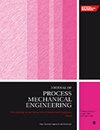利用纳米流体对高聚光光伏系统的被动和主动冷却方法进行实验评估
IF 2.2
4区 工程技术
Q2 ENGINEERING, MECHANICAL
Proceedings of the Institution of Mechanical Engineers, Part E: Journal of Process Mechanical Engineering
Pub Date : 2024-08-23
DOI:10.1177/09544089241275002
引用次数: 0
摘要
高聚光光伏(HCPV)系统需要冷却方法来保持电池效率。无源鳍片散热器和有源微通道热交换器是潜在的冷却解决方案。纳米流体是一种新兴的冷却剂,可增强微通道中的热传递。这项研究通过实验评估了用于冷却 HCPV 系统的翅片散热器和微通道热交换器的性能。研究还考察了微通道热交换器中 0.0005-0.005 Vol% 浓度的纳米银流体。在室外 500-1100 W/m2 的太阳辐照条件下,建立并测试了带有翅片散热器的小型 HCPV 系统。搭建了一个实验台,在热通量为 5-15 W/cm2 和入口温度为 25-35 °C 的条件下,使用水和 50/50 水/乙二醇基液对微通道热交换器进行评估。与基础流体相比,纳米银流体可将传热量提高 20%,但同时也增加了压降。翅片散热器的热阻为 2.5-3.0 °C/W,而微通道热交换器的热阻为 0.5-1.5 °C/W,降低了 60-80%。微通道冷却因其热阻低而在 HCPV 系统中显示出巨大潜力。与基础流体相比,纳米银流体可将传热量提高 20%,但同时也增加了压降。在相同流速下,压降比基础流体高出 5-15% 不等。纳米银流体可以提高传热效果,但需要进行优化,以平衡热量和水力的改善。本文章由计算机程序翻译,如有差异,请以英文原文为准。
Experimental evaluation of passive and active cooling methods for high-concentration photovoltaic systems using nanofluids
High-concentration photovoltaic (HCPV) systems require cooling methods to maintain cell efficiency. Passive fin heat sinks and active microchannel heat exchangers are potential cooling solutions. Nanofluids are an emerging coolant that could enhance heat transfer in microchannels. This work experimentally evaluated the performance of a fin heat sink and microchannel heat exchanger for cooling HCPV systems. The study also examined silver nanofluids at 0.0005–0.005 vol% concentrations in the microchannel heat exchanger. A small-scale HCPV system with the fin heat sink was built and tested outdoors under 500–1100 W/m2 solar irradiance. An experimental bench was constructed to evaluate the microchannel heat exchanger at 5–15 heat fluxes (W/cm2 ) and 25–35 °C inlet temperatures using water and a 50/50 water/ethylene glycol base fluid. Silver nanofluids increased heat transfer up to 20% but also increased pressure drop compared to base fluids. The fin heat sink achieved 2.5–3.0 °C/W thermal resistance, while the microchannel heat exchanger exhibited 0.5–1.5 °C/W, a 60–80% reduction. Microchannel cooling shows excellent potential for HCPV systems due to its low thermal resistance. Silver nanofluids increased heat transfer up to 20% but also increased pressure drop compared to base fluids. The pressure drop penalty ranged from 5–15% over the base fluid at the same flow rates. Silver nanofluids can enhance heat transfer but require optimization to balance thermal and hydraulic improvements.
求助全文
通过发布文献求助,成功后即可免费获取论文全文。
去求助
来源期刊
CiteScore
3.80
自引率
16.70%
发文量
370
审稿时长
6 months
期刊介绍:
The Journal of Process Mechanical Engineering publishes high-quality, peer-reviewed papers covering a broad area of mechanical engineering activities associated with the design and operation of process equipment.

 求助内容:
求助内容: 应助结果提醒方式:
应助结果提醒方式:


